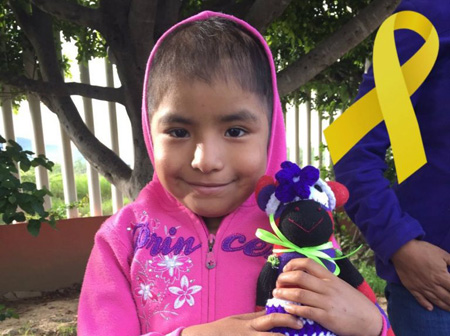
With September as Childhood Cancer Awareness month, people around the nation are “Going Gold” in support of the cause. According to CureSearch research statistics, every day 43 children are diagnosed with cancer; about 12% of all children diagnosed do not survive. Unfortunately, childhood cancer research remains vastly underfunded in comparison to other adult cancer campaigns – and has not garnered the momentum that the “Pink” movement for breast cancer awareness has achieved.
In addition to funding problems for research into childhood cancers, there are also serious disparities in mortality rates. This has a devastating impact on children in black and brown populations. Although non-Hispanic white children are more likely to be diagnosed with cancer, children of other racial/ethnic groups are less likely to survive once diagnosed. This is attributed to a number of factors, including access to quality healthcare and cultural barriers that are rarely mentioned in the medical community.
It was recently reported that cancer has become the leading cause of death among Hispanics (to use the U.S. Census term for Latinx people), accounting for 22% of deaths in the Latinx community. These numbers are more than statistics. They represent a reality that has dramatically shaped people’s experiences with chronic illness and disease. For instance, 27 year old Chicago resident Mayra Díaz was diagnosed with leukemia when she was 11 years old, and then suffered a relapse when she was 14. It’s been over ten years since she officially went into remission, but she remembers many of the difficulties navigating her treatment.
“My family was low income,” Díaz said. “And we had to rely on public aid to cover my medical costs, but not all of the necessary labs and tests were covered by the insurance. My parents had to deal with the financial stress of having to pay thousands of dollars out of pocket for even some of the most basic tests.”
Not unlike Diaz’s own experiences, non-white families often find the treatments options limiting due to high cost and restrictive public aid. In fact, the U.S. ranks poorly within many health-related categories globally. According to a report released by Forbes, in 2015, the U.S. ranked last in life expectancy for men and second to last for women among the 17 wealthiest nations. This is something Díaz also faced once she became an adult and had to consider the long-term consequences of chemotherapy and radiation. “Once I turned 18 and I was no longer eligible for public assistance, I had no choice but to discontinue my annual visits with my oncologist.”
Similarly, St. Jude’s Children Hospital conducted a study that determined the treatment outcome for Black children with cancer has been significantly worse than for white children. The data was collected over a 15-year study period at St. Jude’s Children’s Research Hospital and consisted of 19.1% Black patients and 75.4% white patients (5.5% of the patients representing other races/ethnicities and were excluded) compared with 9.8% blacks and 57.6% whites in the the Surveillance, Epidemiology, and End Results (SEER) program (33.6% representing other races/ethnicities and were excluded). Analysis of the SEER data, which comes from the program of the National Cancer Institute that works to provide information on cancer statistics in an effort to reduce the burden of cancer among the U.S. population, showed significantly worse outcomes for Black patients in the vast majority of disease categories. These findings contrast sharply with the similar 5-year survival rates for Black and white children with any cancer treated specifically at SJCRH. Based on this contrast, one conclusion that can likely be drawn is the often life-saving importance of the location where a patient seeks treatment and the overall quality of healthcare provided.
While lack of resources and access to quality healthcare remain commonplace concerns for Black and Latinx patients, there is also a lingering hesitation to confront the cultural stigmas and conflicts around the medical establishment.
For many Black patients and other kids of color, it is difficult to navigate mental and physical health in spaces that have been numerically dominated by white faces. Kyle Harvey, a current resident of Los Angeles California, is a 27-year-old childhood cancer survivor. He was diagnosed with Rhabdomyosarcoma at age six, and Osteosarcoma at age 12. He said that being a young Black kid with in the hospital came with difficulties. It was often hard for him to identify with fellow survivors because he didn’t see a lot of patients that looked like him, “I know plenty of women with breast cancer, but as a black male there’s a certain expectation of strength we have to have and provide.”
Similarly for Latinx communities, the issue of whether a space can be considered safe is deeply political. A PewReserch Center study from 2009 concluded that six-in-ten Latinx adults living in the United States, who are not citizens or legal permanent residents, lack health insurance. Going out in public may make them more vulnerable to being exposed to immigration authorities. This affects not only those who are directly seeking treatment, but caretakers who are responsible for overseeing ill children. In addition to legal concerns, there are language barriers that lead to a lack of understanding about new healthcare law regulations, or make people hesitant to seek resources outside of home remedies. Indigenous communities have a similar distrust of big pharma and have overall less satisfaction with medical treatment received for cancer-related procedures. In fact, cancer mortality rates for Native Americans are among the highest of all racial and ethnic groups in the United States.
Nevertheless, these issues do not stop with the ending of treatment; 60% of children who survive cancer suffer later effects, such as infertility, heart failure and secondary cancers. The need for better long-term health care is particularly critical within marginalized populations, and it will continue to be so until the social constructs around healthcare justice begin to change. Centering the social, cultural and political issues in the conversations we have about healthcare is just as necessary as addressing racial and environmental justice. Until we can begin to acknowledge the structural inequalities in our healthcare system, our young children of color will continue to pay a terrible cost.
Photo: Latino child cancer survivor. | worldchildcancer.us









Comments